The Nobel Prize in Chemistry 2014: beyond the diffraction limit in microscopy
October 10, 2014

(Credit: The Royal Swedish Academy of Sciences)
The Royal Swedish Academy of Sciences has awarded the Nobel Prize in Chemistry for 2014 to three scientists for the development of super-resolved fluorescence microscopy: Eric Betzig, Janelia Research Campus, Howard Hughes Medical Institute; Stefan W. Hell, Max Planck Institute for Biophysical Chemistry and German Cancer Research Center, Heidelberg; and William E. Moerner, Stanford University.
The Prize amount: SEK 8 million (US$1.1 million or €1.16 million), to be shared equally between the Laureates.
The invention of nanoscopy
For a long time optical, microscopy was held back by a presumed limitation: that it would never obtain a better resolution than half the wavelength of light, the academy notes in a statement.
“Helped by fluorescent molecules, the Nobel Laureates in Chemistry 2014 ingeniously circumvented this limitation,” the Academy notes. “Their ground-breaking work has brought optical microscopy into the ‘nanodimension.’
“In what has become known as nanoscopy, scientists visualize the pathways of individual molecules inside living cells. They can see how molecules create synapses between nerve cells in the brain; they can track proteins involved in Parkinson’s, Alzheimer’s and Huntington’s diseases as they aggregate; they can follow individual proteins in fertilized eggs as these divide into embryos.”
The diffraction limit

Abbe’s diffraction limit (credit: Johan Jarnestad /The Royal Swedish Academy of Sciences)
In 1873, the microscopist Ernst Abbe stipulated a physical limit for the maximum resolution of traditional optical microscopy: 0.2 micrometers, or 200 nanometers (the shortest wavelength for visible light, the extreme limit of violet). The three Nobel laureates bypassed this limit, extending our view into the nanoworld.
Two separate principles were rewarded.

The principle of STED microscopy (credit: Johan Jarnestad /The Royal Swedish Academy of Sciences)
One enables the method stimulated emission depletion (STED) microscopy, developed by Stefan Hell in 2000 (listen to interview with Stefan W. Hell from the press conference). Two laser beams are utilized; one stimulates fluorescent molecules to glow, another cancels out all fluorescence except for that in a nanometer-sized volume. Scanning over the sample, nanometer for nanometer, yields an image with a resolution better than Abbe’s limit.

The principle of single-molecule microscopy (credit: Johan Jarnestad /The Royal Swedish Academy of Sciences)
Eric Betzig and William Moerner, working separately, laid the foundation for the second method, single-molecule microscopy. The idea is to turn the fluorescence of individual molecules on and off. Scientists image the same area multiple times, letting just a few interspersed molecules glow each time. Superimposing these images yields a dense super-image resolved at the nanolevel. In 2006 Eric Betzig utilized this method for the first time.
Today, nanoscopy is used worldwide, an essential scientific research tool.